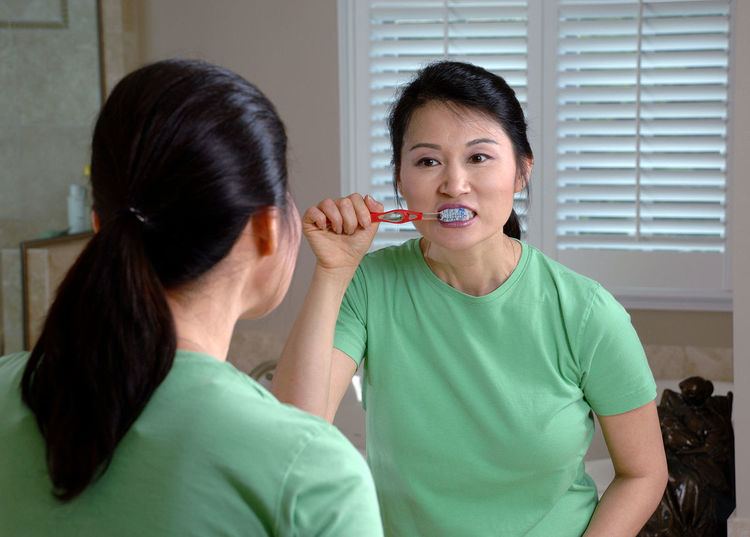 | ||
Tooth brushing is the act of scrubbing teeth with a toothbrush equipped with toothpaste. Since only two thirds of the outer tooth can be reached by a toothbrush, interdental cleaning (with floss or an interdental brush) can usefully accompany tooth brushing. Together, these two activities are the primary means of cleaning teeth, one of the main aspects of oral hygiene.
Contents
Brushing teeth properly helps prevent cavities, and periodontal, or gum disease, which causes at least one-third of adult tooth loss. If teeth are not brushed correctly and frequently, it could lead to the calcification of saliva minerals, forming tartar. Tartar hardens (then referred to as 'calculus') if not removed every 24 hours. Poor dental health has been associated with heart disease and shortened life expectancy.
History
As long ago as 3000 BC, the ancient Egyptians constructed crude toothbrushes from twigs and leaves to clean their teeth. Similarly, other cultures such as the Greeks, Romans, Arabs and Indians cleaned their teeth with twigs. Some would fray one end of the twig so that it could penetrate between the teeth more effectively.
Modern day toothbrushing as a regular habit became prevalent in Europe after contact with the Muslim world in Africa and Asia where the people's teeth remained healthy into old age. It was advised as a scientifically supported practice toward the end of the 17th century. The modern toothbrush was developed in England in 1780. While languishing in jail, Thomas Addis decided to drill holes into a sheep's tibia, and pulled through the bristles of boar hair. While he was credited with the discovery of the modern toothbrush, a similar design has since been discovered in China from 1400. In the United States, although toothbrushes were available at the end of the 19th century, the practice did not become widespread until after the Second World War, when U.S. soldiers continued the toothbrushing that had been required during their military service.
Frequency
Although there is a consensus that a thorough toothbrushing once a day is sufficient for maintaining oral health, most dentists recommend patients brush twice a day since a sufficient level of thoroughness in brushing is not normally achieved.
Proper technique
The front and backs of teeth should be brushed with the toothbrush at a 45 degree angle towards the gumline, moving the brush in a back and forth rolling motion that makes contact with the gumline and tooth. To brush the backs of the front teeth the brush should be held vertically to the tooth and moved in an up and down motion. The chewing surfaces of the teeth are brushed with a forward and back motion, with the toothbrush pointing straight at the tooth.
Toothbrush
A toothbrush is an instrument used to clean teeth, consisting of a small brush on a handle. Toothpaste, often containing fluoride, is commonly added to a toothbrush to aid in cleaning. Toothbrushes come in manual and electric varieties. Although there is conflicting evidence as to which is more effective, most evidence points to electric toothbrushes with an oscillatory motion being more effective than manual toothbrushes, with toothbrushes lacking an oscillatory motion being equivalent. Both manual and electric toothbrushes are effective, however, and it is often recommended that people use whichever one they feel comfortable with and will be more likely to regularly brush with.
Toothbrushes are offered with varying textures of bristles, and come in many different forms and sizes. Most dentists recommend using a toothbrush labelled "soft", since firmer bristled toothbrushes can damage tooth enamel and irritate gums as indicated by the American Dental Association. Toothbrushes are often made from synthetic fibers, although natural toothbrushes are also known in many parts of the world. Those with dentures may also brush their teeth with traditional tooth brushes, specially made denture brushes or denture cleaners.
Toothpaste
Toothpaste is a paste or gel dentifrice used to clean and improve the aesthetic appearance and health of teeth. It is almost always used in conjunction with a toothbrush. Toothpaste use can promote good oral hygiene: it can aid in the removal of dental plaque and food from the teeth, it can aid in the elimination and/or masking of halitosis when tonsil stones are not the cause, and it can deliver active ingredients such as fluoride to prevent tooth and gum (Gingiva) disease.
Tooth powder
Tooth powder (or 'toothpaste powder') is an alternative to toothpaste. It may be recommended for people with sensitive teeth. Tooth powder typically does not contain the chemical sodium lauryl sulphate which can be a skin irritant. The function of sodium lauryl sulphate is to form suds when teeth are brushed. It is a common chemical in toothpaste. Those with dentures may also use denture cleaner which can also come in powder format.
